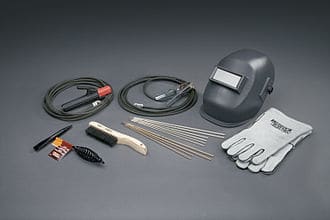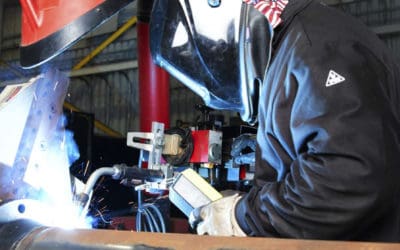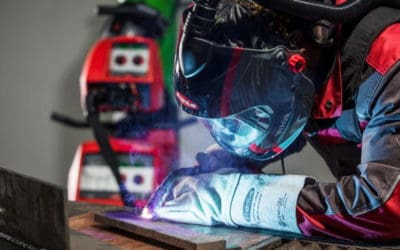Shielded metal arc welding (SMAW), also known as manual metal arc welding (MMA or MMAW), or regularly as stick welding is a manual arc welding process that uses a consumable 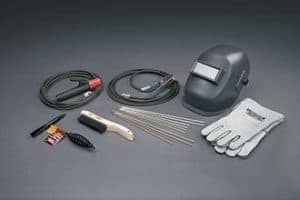 electrode covered with a flux to produce the weld. An electric current, in the form of either alternating current or direct current from a welding power supply, is used to form an arc between the electrode and the metals to be joined.
electrode covered with a flux to produce the weld. An electric current, in the form of either alternating current or direct current from a welding power supply, is used to form an arc between the electrode and the metals to be joined.
The workpiece and the electrode melts form a weld pool of molten metal that solidifies to form a joint. As the weld is laid, the flux coating of the electrode disintegrates, giving off vapours that serve as a shielding gas and providing a layer of slag, both of which protect the weld area from atmospheric contamination.
Shielded metal arc welding is one of the world’s first and most popular welding processes because of the versatility of the process and the simplicity of its equipment and operation. It dominates other welding processes in the maintenance and repair industry, and though flux-cored arc welding is growing in popularity, SMAW continues to be used extensively in the construction of heavy steel structures and in industrial fabrication. The process is used primarily to weld iron and steels (including stainless steel) but aluminium, nickel and copper alloys can also be welded with this SMAW.
Basic stick welding is not difficult to learn but knowing the methods to manipulate the electrode, setting up for welding, and completing a quality of finished joint are completely different. The formula for a beginner to achieve a good, solid weld is mostly joint preparation and proper machine set up. One of the biggest factors to consider is whether you will be welding in a fabrication workshop or in the field.
Let’s just assume you will be repairing welding machinery or structural elements in the field, such as an earthmover, ore truck or a simple steel gate. Stick welding is perfect for the job. With the right welding electrodes, you can weld most metals, even if the metal is a little rusty.
How SMAW Works
To strike the electric arc, the electrode is brought into contact with the workpiece by a very light touch with the electrode to the base metal, then is pulled back slightly. This initiates the arc and thus the melting of the workpiece and the consumable electrode, and causes droplets of the electrode to be passed from the electrode to the weld pool.
 Striking an arc, which varies widely based upon electrode and workpiece composition, can be the hardest skill for beginners. The orientation of the electrode to workpiece is where most stumble. When striking the arc, the tip of the electrode needs to be less than 90° angle to the workpiece. This allows the arc to be initiated, whereupon the weld pool begins to develop.
Striking an arc, which varies widely based upon electrode and workpiece composition, can be the hardest skill for beginners. The orientation of the electrode to workpiece is where most stumble. When striking the arc, the tip of the electrode needs to be less than 90° angle to the workpiece. This allows the arc to be initiated, whereupon the weld pool begins to develop.
As the electrode melts, the flux covering disintegrates, giving off shielding gases that protect the weld pool from the surrounding air and other atmospheric gases. In addition, the flux provides molten slag which covers the filler metal as it travels from the electrode to the weld pool. Once part of the weld pool, the slag floats to the surface and protects the weld from contamination as it solidifies.
Once the weld has completely solidified and cool sufficiently, the hardened slag covering must be chipped away to reveal the finished weld. As welding progresses and the electrode melts, the welder must periodically stop to insert a new electrode into the torch. This activity, combined with chipping away the slag, reduces the amount of time that the welder can spend laying the weld, making SMAW one of the least efficient welding processes. In general, the operating factor, or the percentage of operator’s time spent actually welding, is approximately 25%.
The actual welding technique employed depends on the electrode, the composition of the workpiece, and the position of the joint being welded. Before you begin to weld, you need to set your welding machine to the proper settings for the electrode you are going to use. This is the most important part. Even experienced welders, with an incorrect machine set-up, will not produce a quality weld. Having a machine set up correctly is critical and, as with all welding, joint cleanliness is also a key parameter.
The choice of electrode and welding position also determine the welding speed. Downhand welds require the least operator skill, and can be completed with both larger diameter electrodes that melt quickly but solidify slowly. This permits higher welding speeds.
Positional welding requires a greater degree of operator skill, and often necessitates the use of an electrode that has a slag which solidifies quickly. This will prevent molten metal from the weld pool flowing out. However, this generally means that the electrode melts less quickly, thus increasing the time required to lay the weld.
Power supply
The power supply used in SMAW has constant current output, ensuring that the current remains relatively constant, 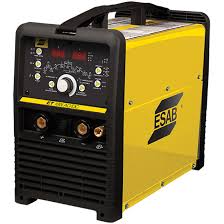 even if the arc distance and voltage change. This is important because most applications of SMAW are manual, requiring that an operator hold the welding torch.
even if the arc distance and voltage change. This is important because most applications of SMAW are manual, requiring that an operator hold the welding torch.
The preferred polarity of the SMAW system depends primarily upon the electrode being used and the desired properties of the weld.
Direct current with a negatively charged electrode (DCEN) causes heat to build up on the electrode, increasing the electrode melting rate and decreasing the depth of the weld. Reversing the polarity so that the electrode is positively charged (DCEP) and the workpiece is negatively charged increases the weld penetration. With alternating current the polarity changes over 100 times per second, creating an even heat distribution and providing a balance between electrode melting rate and penetration.
Typically, the equipment used for SMAW consists of a step-down transformer, and for direct current models a rectifier, which converts alternating current into direct current. Because the power normally supplied to the welding machine is high-voltage alternating current, the welding transformer is used to reduce the voltage and increase the current. As a result, instead of 220 V at 50 A, for example, the power supplied by the transformer is around 17–45 V at currents up to 600 A.
A number of different types of transformers can be used to produce this effect, including inverter machines. Inverters, which are smaller and thus more portable, use electronic components to change the current characteristics.
Electrical generators and alternators are frequently used in the field as a portable welding power supply. The engine driven units are most practical in field work where the welding often must be done out of doors and in locations where transformer type welders are not usable because there is no power source available to be transformed.
Electrodes
The choice of electrode for SMAW depends on a number of factors, including the weld material, welding position and the desired weld properties. The electrode is coated in a flux, which gives off gases as it decomposes to prevent weld contamination, introduces de-oxidisers to purify the weld, causes weld-protecting slag to form, improves the arc stability, and provides alloying elements to improve the weld quality.
Electrodes can be divided into three groups.
Fast-fill electrodes are designed to melt quickly so that the welding speed can be maximized, while fast-freeze electrodes supply filler metal that solidifies quickly, making welding in a variety of positions possible by preventing the weld pool from shifting significantly before solidifying.
The composition of the electrode core is generally similar and sometimes identical to that of the base material. However, a slight difference in alloy composition can strongly impact the properties of the resulting weld. This is especially true of alloy steels such as HSLA steels. Likewise, electrodes of compositions similar to those of the base materials are often used for welding non-ferrous materials like aluminium and copper.
Sometimes it is necessary to use electrodes with core materials significantly different from the base material. For example, stainless steel electrodes are sometimes used to weld two pieces of carbon steel, and are often utilized to weld stainless steel workpieces with carbon steel workpieces.
Electrode coatings can consist of a number of different compounds, including:
- Rutile
- Calcium fluoride
- Cellulose
- Iron powder
Rutile electrodes, coated with 25%–45% TiO2 flux are characterised by ease of use and good appearance of the resulting weld. However, they create welds with high hydrogen content, encouraging embrittlement and cracking.
Electrodes containing calcium fluoride (CaF2), sometimes known as basic or low-hydrogen electrodes, are hygroscopic and must be stored in dry conditions. They produce strong welds, but with a coarse and convex-shaped joint surface.
Electrodes coated with cellulose, especially when combined with rutile, provide deep weld penetration, but because of their high moisture content, special procedures must be used to prevent excessive risk of cracking.
Finally, iron powder is a common coating additive that increases the deposition rate at which the electrode fills the weld joint, up to twice as fast.
To identify different electrodes, the American Welding Society established a system that assigns electrodes with a four- or five-digit number. Covered electrodes made of mild or low alloy steel carry the prefix E, followed by their number. The first two or three digits of the number specify the tensile strength of the weld metal, in thousand pounds per square inch (ksi). The penultimate digit generally identifies the welding positions permissible with the electrode, typically using the values 1 (normally fast-freeze electrodes, implying all position welding) and 2 (normally fast-fill electrodes, implying horizontal welding only). The welding current and type of electrode covering are specified by the last two digits together. When applicable, a suffix is used to denote the alloying element being contributed by the electrode.
Common electrodes include the E6010, a fast-freeze, all-position electrode with a minimum tensile strength of 60 ksi (410 MPa) which is operated using DCEP. E6011 is similar except its flux coating allows it to be used with alternating current in addition to DCEP. E7024 is a fast-fill electrode, used primarily to make flat or horizontal welds using AC, DCEN, or DCEP. Examples of fill-freeze electrodes are the E6012, E6013, and E7014, all of which provide a compromise between fast welding speeds and all-position welding. The electrodes employed are coated heavily in flux, and are typically 71 cm in length and about 6.35 mm thick.
Some Basic Electrode Selection Information
Welding electrode selection for SMAW is fairly straight forward. For the purpose of steel machinery repair, a 6011 will do. A 6011 is a good general maintenance rod. It does well in all positions and tolerates a less-than-perfect joint.
Some other commonly used rods used for welding steel are:
- 6010 deep penetration works well in all positions and is excellent on dirtier metals.
- 6011 deep penetration works well in all positions and is excellent on dirtier metals.
- 6013 mild penetration works well in all positions and needs a cleaner joint.
- 7018 low hydrogen electrode with mild penetration works well in all positions and works best on clean metals.
- 7024 mild penetration works well in the flat positions and needs a clean joint.
Quality
Common quality issues related to SMAW include weld spatter, porosity, poor fusion, shallow penetration, and cracking.
Weld spatter, while not affecting the integrity of the weld, damages its appearance and increases cleaning costs. It is usually caused by too high a welding current, a long arc, or arc blow. Arc blow can also cause porosity in the weld, as can joint contamination, high welding speed, and a long welding arc, especially when low-hydrogen electrodes are used.
Porosity, often not visible without the use of ultrasonic or radiographic non-destructive testing. It is a serious concern because it can potentially weaken the weld. Poor sidewall or root fusion can also affect the strength of the weld. It is caused by low current, contaminated joint surfaces, or the use of an improper electrode.
Shallow penetration, another detriment to weld strength, can be addressed by decreasing welding speed, increasing the current or using a smaller electrode. Any of these discontinuities can increase the likelihood of weld cracking
Other factors are involved as well. High carbon, alloy or sulphur content in the base material can lead to cracking, especially if low-hydrogen electrodes and preheating are not employed.
Furthermore, workpieces should not be excessively restrained, as this introduces residual stresses into the weld and can cause cracking as the weld cools and contracts.
Basic Stick Welding Machine Set-Up
The first steps in welding machine set-up is selecting your rod, then set the polarity according to the manufacturer’s recommendation, and finally set the welding machine to the amperage range that the manufactures recommend.
To fine-tune the welding machine to the metal, use some scrap metal that is as close as possible to the thickness of the metal you will be welding. This is important because welding different thickness metals requires different setting.
The welding machine should be set with enough amperage to burn the electrode smoothly without sticking. Too high an amperage will cause the electrode to overheat, and result in damaged flux covering or the electrode will turn cherry red.
Basic Stick Welding Technique
Before you start welding it is imperative that you get comfortable. Use two hands to hold the handle and brace yourself in any and every possible way to make sure you are in a comfortable position. Control of the electrode is the biggest factor when it comes to good welding technique.
There are a few ways to move the rod and see the puddle of metal in the crater. In SMAW, you normally drag the rod. In GMAW and GTAW you usually push the torch.
With most welding electrodes you can use the same techniques in most positions, but there are certain patterns welders favour for good reason. The most common techniques are:
- Moving the electrode in a back and forth motion.
- Moving the electrode in a slightly circular motion.
- Weaving a side to side motion (for wider welds).
Basic welding guidelines are that for 6010 and 6011 you move the electrode in a back/forth motion. For low hydrogen rods like a 7018 or 7024 you complete a circular motion or just hold a steady position and wait for the rod to fill the gap. With low hydrogen rods or any rods that have a lot of flux you want to avoid back/forth motion because the flux can get trapped in the weld – a slag inclusion.
Another good practice is to make the weld bead width approximately twice the width of the electrode.
Welding in different position changes your welding technique and the machine settings.
Typically, setting your machine for flat (1G/1F) will allow you to weld flat, horizontal (2G/2F), vertical down, and overhead (4G/4F) depending on the electrode type.
Vertical up (3G) usually requires less amperage. What happens with vertical up is that when you weld, the rods arc gouges a crater into the metal and then fills the joint with filler metal. That is why the weld is so strong even though the setting are lower.
As a general guide, the following electrode to workpiece angles can be employed:
| Welding Position | Typical Electrode Angle | Electrode Manipulation |
| 1G/1F | 10 – 30° | Back/forth
Circular |
| 2G/2F | Electrode at 45° degrees and drag it toward your direction of travel with a side tilt of 10 – 30° | Back/forth
Circular |
| 3G/3F | Electrode at 45° degrees | Tight weave motion |
| 4G | 10 – 30° | Back/forth
Circular |
Safety
SMAW can be a hazardous if proper precautions are not taken. The process uses an open electric arc, which presents a risk of burns which are prevented by personal protective equipment in the form of heavy leather gloves and long sleeve jackets.
Additionally, the brightness of the weld arc can lead to a condition called arc eye, in which ultraviolet light causes inflammation of the cornea and can burn the retinas of the eyes.
To protect bystanders, especially in industrial environments, translucent welding curtains often surround the welding area. These curtains, shield nearby workers from exposure to the UV light from the electric arc, but should not be used as a substitute to the helmet shade filter.
Vaporizing metal and flux materials expose welders to dangerous fume and particulate matter. The fume contains particles of various types of oxides. The size of the particles in question tends to influence the toxicity of the fumes, with smaller particles presenting a greater danger. Additionally, gases like carbon dioxide and ozone can form, which can prove dangerous if ventilation is inadequate.
Conclusion
The conclusion to basic welding is:
- Get the proper safety equipment.
- Clean your joint properly.
- Set your machine right on scrap metal.
- Weld using the right technique!
It’s not hard, but take away one of these steps and you will find yourself struggling or perhaps even seriously injured.
